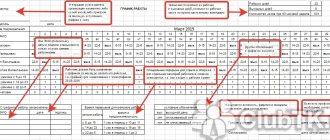Shift mode of operation: main features
Article 101 of the Labor Code of the Russian Federation is responsible for the precise definition of shift work. The schedule involves several main shifts that are used to organize production. This is usually due to the need to ensure a specific working day. Or the opportunity to organize processes more efficiently so that profits and productivity increase.
All workers must complete a specific amount of work in a specified amount of time. The Employment Contract fixes all the important facts related to this area. The schedule also contains detailed information regarding the organization of workdays.
What work schedules are used in practice?
Five days or six days
Working on a “5 through 2” or “6 through 1” schedule is one of the most common in Russian practice. Sunday must be a day off
, and the second day off in a five-day week is negotiated separately. For example, in trading, the holiday often falls on Monday.
The length of the working day for a five-day work week is 8 hours, and for a six-day week it is not clearly established, but in practice it is usually 5 days of 7 hours, and on the sixth day - 5 hours. The main thing is that the total length of the working week should not exceed 40 hours.
With a five-day or six-day work week, employees are not required to go to work on weekends. But sometimes this is required by the employer. In this case, working on days off is possible subject to the following conditions:
- employee consent (in writing);
- consent of the trade union (in some cases);
- availability of the employer's order in writing.
For work beyond the established schedule, an increased wage or an additional day of rest is provided.
If an employee’s employment or collective agreement stipulates an irregular working day, he will have to go to work by order of the employer and on days off, and his consent is not required.
Shift work
A shift work schedule involves a person working at different times on different days. Shift work is introduced if:
- the presence of an employee around the clock is required - security activities, medicine, etc.;
- it is necessary to use existing production assets more efficiently - convenience stores, service enterprises, round-the-clock work in industrial enterprises.
Most often they work shifts according to the following schedules:
- “2 through 2”, “3 through 3” , etc. These are usually 12 hour shifts (resulting in approximately 42 working hours per week). This is how they work in trade, transport, catering, etc.;
- “in three days . This means that a person works one 24-hour shift, after which he rests for 3 days. This is often done in medicine or security.
Despite the fact that shifts are set to a certain length, the employer must still determine the time for rest and meals (from 30 minutes to 2 hours).
The working time of each employee working on a shift schedule must be taken into account individually. Moreover, it is necessary to keep separate records of time worked during the day and at night (additional payments are due for night work).
You cannot install 2 shifts in a row. In addition, when planning shifts, it is worth considering a minimum weekly uninterrupted rest of 42 hours.
Floating, sliding, flexible
A flexible, sliding or free work schedule is a schedule in which the working time is agreed upon individually
.
The start and end times of work, as well as the total duration of the working day, are agreed upon. After this, the employee will not be able to independently change the schedule without agreeing with the employer (even though the schedule is called free).
The legislation distinguishes 2 parts of a flexible schedule:
- fixed time – those hours that the employee must be at the workplace;
- variable time – hours during which an employee can be present at the workplace at his own discretion.
The main thing is that the employee works the agreed amount of working time. Remuneration is calculated based on the actual time worked, or in other ways as agreed.
A flexible work schedule can only be established with the consent of both parties - the employer and the employee. The employer's consent is not required only in cases where the employee has a child under 14 years of age or a disabled child.
For some professions, a flexible schedule is a prerequisite (in particular, for emergency responders on communication networks).
Shift method
Shift work is a way of organizing work when an employee does not return to his place of residence after work due to the fact that the place of work is far from home.
. Most often, the rotation method has a seasonal basis.
They work on a rotational basis mainly in the fields of mining, logging, construction, maritime transport, etc.
The duration of the shift (that is, the period when the employee lives outside the home) cannot be more than 1 month, but the law allows this period to be extended to 3 months in agreement with trade unions.
When working on a rotational basis, working conditions differ from usual ones. They usually work on a shift schedule; the duration of one shift cannot be longer than 12 hours.
For such work, workers receive an agreed payment for the hours worked, plus a special allowance for the rotation method. This allowance is paid for all days on duty, as well as for days spent traveling there and back.
If the place of work on a shift is in the Far North or equivalent areas, then the employee receives additional allowances for working conditions. He also has the right to additional days of vacation.
Distant work
Remote work is the dream of many, because you don’t have to waste time and money getting to your workplace. This is not available to everyone; only certain types of activities (such as the work of programmers) can be transferred to remote work.
Formally, hiring an employee for remote employment is no different from hiring an employee in an office.
. The employee must provide the same documents, an employment contract is concluded with him, an employment order is issued and a personal card is filled out.
The main difference is that when working remotely, an employee is located outside the employer’s location, or away from stationary workplaces and uses the Internet for work.
The work schedule of a remote employee is discussed with him individually, but it must comply with the Labor Code. As a rule, employers agree with employees on a work schedule, when the employee must be present at the workplace (at his location) at certain hours and on certain days.
Since, from the point of view of the law, remote work is no different from “regular” office work, insurance premiums and personal income tax are paid for the employee, and he has the right to the same social package as others (vacation, sick leave, etc. ).
Freelancers
Freelancers are usually called those who do not have a permanent place of work and provide themselves with work independently. Most often, IT sector specialists work through freelancing, but freelancers can be called, for example, builders who independently seek orders for themselves.
Most of those who call themselves freelancers work without official registration. They do not earn insurance coverage (then it will be more difficult to retire), and do not have paid vacations or sick leave.
If we consider “official” freelancers, then in Russia they have to register as individual entrepreneurs
(IP). Now in 4 regions you can already register as self-employed, it will be more profitable.
In the case of work through the registration of an individual entrepreneur, no regulations stipulate either the length of the working week or the length of working hours per day. In practice, most freelancers work as much time as they wish (or depending on the availability of orders and time) - that is, much more than 40 hours a week.
In order to provide services as a freelancer, through an individual entrepreneur or simply as an individual, it is best to enter into a contract or service agreement with the customer. This document specifies the content of the work and the timing of its completion.
It is best not to “run” from the law, but to work with official registration. When working as an individual entrepreneur, it will be enough to pay 6% of income and insurance premiums (about 36 thousand rubles per year).
What are the advantages of a shift work schedule?
Let us list the obvious advantages of using such a scheme for employees.
| Benefits of shifts | Comments |
| Lack of congestion on the roads due to rush hour | Resolving everyday issues is simplified with the shift option. For example, when days off are scheduled on regular weekdays. |
| Convenient combination with study | A shift schedule is often the best choice for students. They often manage to negotiate with teachers so that they can skip classes from time to time for work. |
| Convenient scheme | Such options are suitable for those who, for some reason, cannot actively travel every day from one place to another. |
| If necessary, employees can change shifts with each other | A shift schedule helps simplify such tasks. Subordinates can agree among themselves; it is not necessary to report every step to their superiors. |
Types of shift work
The legislation offers several implementation schemes:
- 2-shift.
- 3-shift.
- 4-shift.
The main differences between the different options are the combination of work and rest time. It is important that at the end of the specified reporting time, all indicators are brought to current standards, in accordance with the legislation of the Russian Federation. According to Article 104 of the Labor Code of the Russian Federation, you can choose different intervals not exceeding a year.
As for the formation itself, it also relies on several factors:
- Allowable rest interval.
- Limits on the duration of the labor process.
- Total number of employees.
In personnel document flow, rules have been adopted according to which it is necessary to alternate working days with weekends. For example, 2 2 means that there are two working days first, followed by two weekends.
Setting modes involves using one of the following several shifts:
- 2 2. One of the modes that has become especially popular in practice. 12 hours of work followed by rest is the organization method for 90% of cases. Day and night work are also alternated if necessary.
- 4 3. Four consecutive days of work are followed by three days of rest.
- 1 3. Or “in three days.”
- 4 2. 2 2 3. Labor document flow establishes specific numbers. It is then drawn up as a report on the organization of work to date. They allow for shift lengths that fluctuate. The main thing is to remember that it is inadmissible to violate the rules established by law.
The legislative framework
Article 103 of the Labor Code of the Russian Federation provides the concept of shift work and the grounds for introducing a shift work schedule. The legislator attributes the following objective circumstances to the reasons for introducing shift work:
- The duration of the production process associated with technological features, in which it is inevitable that the permissible duration of daily work will be exceeded. Or with the urgent need of society for the provision of certain services around the clock. For example: organizations providing security services (private security companies/private security companies); 24-hour emergency medical assistance.
- The need for highly efficient operation of technical equipment, a larger number of products, and certain services. For example, 24-hour operation of shops and canteens.
Thus, shift work schedules are widely used in different areas: in the public service sector, in continuous production where conveyors and production lines are involved, the stop of which is not economically feasible.
According to the law, a shift schedule is a document regulating the start and end of work, the type of shift (day, night, etc.), the duration of breaks for rest and food. The shift schedule is work in 2, 3 or 4 shifts.
Three-shift work schedule
If there are a lot of employees and production is not interrupted, it is important to use work divided into four teams. Workers are divided into exactly the same number of teams. One team rests every day, the remaining three work. The distribution of shifts in most Russian regions is as follows:
- Four days on the night shift, followed by two days off.
- Four days with a day shift, then 1 day off.
- Shift in the evening, 4 working days followed by 1 day off.
The actual hours worked by the crews vary - from 128 to 184 hours. The reporting period is the next few months, for which the preparation is carried out forward. In one month, they are allowed to organize work so that the shortcomings are compensated by overwork in the next segment. It is important to ensure that the weekly working hours are adhered to.
Some enterprises are developing a scheme according to which they are divided into five teams. The breakdown of time spent performing duties affects the final number of days off - 1, 2 or 3.
A ten-day work cycle is most common in enterprises. Each team works from 136 to 152 hours.
WORK SCHEDULE from 02/15/2020, 3×2
| February 2020 | |||||||||||||||||||||||||||||||||||
Mon
|
| March 2020 | |||||||||||||||||||||||||||||||||||||
Mon
|
| 22 - short day © 2021 - www.abc2home.ru |
| February 2020 | |||||||||||||||||||||||||||||||||||
Mon
|
| March 2020 | |||||||||||||||||||||||||||||||||||||
Mon
|
| 22 - short day © 2021 - www.abc2home.ru |
| February 2020 | |||||||||||||||||||||||||||||||||||
Mon
|
| March 2020 | |||||||||||||||||||||||||||||||||||||
Mon
|
| 22 - short day © 2021 - www.abc2home.ru |
You can generate this graph on any device or send it to friends using the link: abc2home.ru/blog/grafik_smennoy_raboty.html?202150010023212232
The answer to our task was very simple: Friends will be able to meet nine days after the start of work on February 24...
Restrictions on the use of a shift schedule
Any employment contracts concluded with subordinates record a description of the shift schedule along with its main conditions. In the process of tabulation there is a subsequent clarification of the schemes used.
The Labor Code of the Russian Federation only talks about which categories of employees definitely cannot be involved in the implementation of such schemes:
- Minors.
- Pregnant women.
Certain other categories of persons covered by intersectoral agreements.
Sometimes involvement in such schemes is allowed, but only if there are agreements in writing from the other party. Typically this rule applies to:
- Citizens who care for sick relatives.
- Persons supporting disabled children under 18 years of age.
- Single parents and guardians, adoptive parents of children under 14 years of age.
- Women raising children under 3 years of age.
- Disabled people, regardless of group.
If managers violate legal requirements, serious penalties may be applied to them. An acceptable option is for employees to challenge the legality of such decisions, using the courts as one of the methods.
Shift schedule, restrictions on its use
A shift schedule is a local regulatory act that determines the working conditions of workers who work in shifts. The development of this document, as well as its approval and mandatory communication to employees engaged in the work process on shift conditions, is the responsibility of the employer.
In Art. 103 of the Labor Code of the Russian Federation notes that, as a general rule, the shift schedule is part of the collective agreement, therefore, it must be agreed upon with the representative body of workers (Article 372 of the Labor Code of the Russian Federation). In the absence of a collective agreement and/or a representative body of employees, the shift schedule in the form of a separate legal act is approved by the manager.
The shift schedule must necessarily contain the essential conditions for working in shift mode:
- number of shifts during the accounting period;
- duration of working hours per shift, its start and end times;
- rest and meal breaks;
- daily and weekly rest time;
- shift rotation schedule.
When drawing up a shift schedule, labor law analysts suggest being guided by the current provisions of the Methodological Recommendations for organizing multi-shift work of production associations (enterprises) of industry, approved by the State Committee for Labor of the USSR (Moscow, 1988).
In the example above, it is logical and effective to use a shift schedule of 4 teams that work in the following mode: 3 teams provide work around the clock in 3 shifts of 8 hours each, the fourth has a rest.
IMPORTANT! If an employment contract with an employee contains a condition on shift work, the employer is obliged to notify him of the shift schedule for the next accounting period at least a month before the start of its validity (Article 103 of the Labor Code of the Russian Federation).
So, in our example, the shift schedule is a tool created by the employer to ensure a work cycle that is technologically longer than the maximum duration of daily work determined by law. This entails the need to work in the evening and night hours.
Labor legislation, protecting the rights of the employee, introduces certain restrictions on the use of labor in the evening and at night and, as, indeed, under any working time regime, requires an established ratio of work and rest time.
The Labor Code of the Russian Federation establishes the following restrictions:
- Art. 103 prohibits the involvement of 2 shifts in a row;
- Art. 96 prohibits the use of labor of pregnant women and workers under 18 years of age at night (according to the Labor Code of the Russian Federation, this is the period from 10 p.m. to 6 a.m.) and limits the possibility of using the labor of disabled people, persons with family responsibilities in relation to young children and other persons, requiring their written consent to work at night, provided that it is permitted by him for medical reasons.
Read about the specifics of organizing work at night in the material “Night work under the Labor Code (nuances).”
About the duration of a work shift when using a schedule
They impose a ban on exceeding the weekly norm of 40 hours established by law. The rules are not canceled for enterprises that introduced a shift schedule. A reference to the description of such conditions is required for the Employment Contract. At the legislative level, the exact duration of shifts is regulated only for workers of specific categories.
For example, bus drivers are prohibited from driving for more than 10 hours at a time. But working hours can be increased to 12 hours if the issue is agreed upon with trade union representatives.
The main thing is that all employees have time to eat and take breaks. It takes no more than 120 minutes to rest.
The manager must also take into account an additional 30 minutes of breaks that are not included in the total written rest period. It doesn't matter whether we are talking about day or night shifts. The absence of such conditions in the text of Labor Agreements leads to a violation of the rights and interests of workers.
How to create a rotating work schedule (sample)
We will draw up a shift schedule for guards (sample for 4 people working “3 + 1” (3 working days - 1 day off).
The legislation does not provide for a unified form. In each organization, the personnel department compiles it individually. The main thing is that it contains the following data:
- FULL NAME. and positions of employees who will work in this mode;
- number of workers per shift;
- duration of duty;
- the order of their alternation;
- rest and meal breaks;
- acquaintance note.
The document is approved by the head of the enterprise. Communication to workers should be ensured at least one month in advance. If working conditions change significantly, the period is doubled.
Everyone signs the document, thereby agreeing to the established regime. If you plan to periodically make changes to it, it is more convenient to approve the shift work calendar not for a year, but for a month. It is stored in the personnel service along with other orders for the enterprise.
If the working day schedule does not suit the employee, he has the right to ask the employer to provide him with more comfortable conditions.
Position
Legislation gives managers the right to decide how certain shifts will be organized at the enterprise. The main thing is to comply with the 40-hour work week requirement. The 167-hour standard extends over months.
Minors, pregnant women and disabled people are categories of citizens for whom certain restrictions on the time of one shift are established. Other circumstances allow decisions to be made that are appropriate for a particular situation. The Labor Code imposes virtually no restrictions in this direction.
Employees are replaced at least once every 24 hours when it comes to shifts. The schedule will not change when one team works for 24 hours or more. It is unacceptable to introduce continuous shifts that last a day.
It is permissible to postpone rest days to any convenient time - such periods are designated “floating”.
Two-by-two schedule with a 12-hour workday
When drawing up such a document, it is important to ensure that in the case of a summarized accounting of the working period there are no violations and it fully satisfies the requirements of the shift schedule (Article 103 of the Labor Code of the Russian Federation).
Let's give an example.
When working 12 hours a day, an employee works 30 / 2 × 12 = 180 hours in a month. Consequently, there is an overtime of 20 hours and it is necessary to comply with the number of days off during the week and month. The total number of working hours per month should not exceed 167. Another feature of the 2-by-2 work mode with a 12-hour shift is that the employee also works on official days off, i.e., on public holidays. At the same time, his work is paid according to the rules of Article 153 of the Labor Code of the Russian Federation.
Features of the organization of the work process
The specifics of the enterprise influence how specifically the shift schedule is organized. It is important to ensure that the established rules also do not violate the current version of the Labor Code.
Documents have a temporary or permanent basis. That is, strictly for a certain period. The manager himself chooses the exact reporting time:
- Month.
- Quarter.
- Half year.
The manager approves this or that schedule, taking into account the opinion of the trade union representatives. The nature of the main work of subordinates determines the total duration of the shifts, or for its individual stages.
For example, they try to shorten shifts in the case of hazardous industries or in the presence of conditions that can harm health. Or extend it when working in the field of art, theater, and other similar areas.
No less than other categories, shift workers are entitled to annual paid leave, sick leave for at least 10 days, and other rights.
Payment for a shift schedule
Wages at a particular enterprise are calculated to an employee based on the established wage system. Depending on this, it can be calculated in two ways.
At a set hourly rate
In this case, to determine the amount to be paid, it is necessary to multiply the rate by the number of hours actually worked by the employee. Data about this is taken from the time sheet maintained at the enterprise.
Example:
The watchman of Hercules LLC works on a shift schedule every other day, so the duration of one of his shifts is 24 hours. Payment is made based on an hourly tariff rate of 90 rubles per hour. It is necessary to calculate an employee’s salary for March if he worked all his shifts and his first working day of the month fell on March 2.
In this case, the number of work shifts is 8, the actual time worked is 192 hours. Therefore the salary is equal to:
Salary = 192 * 90 = 17,280 rub.
However, this amount is not the final amount, because the employee is also entitled to additional payment for night work, as well as for overtime work. The features of such an additional payment will be discussed further.
If in this example the employee worked on a “every two days” schedule, then the number of shifts and hours worked would be 10 and 240, respectively. In this case, the salary is an order of magnitude higher:
Salary = 240 * 90 = 21,600 rub.
In addition to additional pay for night and overtime work, an employee could also qualify for additional money for working on a holiday, since one of his shifts would fall on March 8. However, with such a schedule, there is a lot of overtime in excess of the monthly norm (168 hours), which is undesirable and in some cases may be prohibited by law.
In accordance with the salary established for the employee
In such a situation, it is paid in full, but provided that the employee has worked the standard hours established for the accounting period. If this standard is not met, the salary is proportionally reduced. In case of processing, an additional payment is due.
Example:
Employee of Jeweler LLC Koroleva M.P. works on a shift schedule from 10.00 to 21.00 daily for one week, break - from 14.00 to 15.00, the next week is non-working. Her monthly salary is set at 15,000 rubles. It is necessary to calculate the employee’s salary for April 2021 if the company keeps summarized records of working hours and the accounting period is equal to a month.
First of all, it is necessary to determine the time standard for the month in question, established using the production calendar. It is 168 hours per week, the number of working days in a month is 21 days. The employee's hourly rate is:
Emergency = 15,000 / 168 = 89.3 rubles/hour
In fact, the employee worked 16 working days. The number of hours worked in this case will be:
H = 16 * 10 = 160 hours
Since the employee did not fully work the standard time, her salary will be:
Salary = 160 * 89.3 = 14,285 rubles.
As already noted, in the event of overtime or if part of the shift coincides with night time, the employee is entitled to additional payments to his salary, the minimum amount of which is established by law.
Working hours: basic conditions
The schedules refer to local regulations of enterprises. They are recorded in writing, which must contain a description of the following factors:
- The maximum number of shifts allowed by an enterprise.
- Hours that can be one shift.
- Sequence.
- Weekends and rest hours, between shifts and working days.
- Breaks within one working day.
Be sure to prescribe actions in case the employee next to the one currently performing the work is absent. Do not forget to record the rights and responsibilities of subordinates, the procedure for moving to other schedules, and other similar conditions.
If most of the working time occurs at night, the shift is called a night shift. It is preceded by “evening” time.
16 hour duration for two shifts is maximum. Two 12-hour shifts per day are considered acceptable options.
Employees are prohibited from independently changing the agreement; this cannot be done without approval from the administration.
Making a shift schedule
To correctly draw up a shift schedule, it is necessary to take into account its basic components:
- the accounting period used by the employer and ensuring the balance of working time;
- duration of work, which must be ensured by the shift schedule;
- the procedure for the transition of workers from one shift to work in another;
- actions of an employee when a shift worker fails to show up.
The standard form of the shift schedule is not fixed by law. The employer has the right to prescribe the basic terms of the document in any form. However, the employer is required to take into account the following rules:
- according to Part 2 of Art. 91, part 2 art. 104 of the Labor Code of the Russian Federation, the duration of working hours should not exceed the normal number of working hours established by labor legislation;
- in accordance with Art. 94 of the Labor Code of the Russian Federation, the duration of daily work (shift) for certain categories of workers should not exceed the limit established by law;
- according to Part 1 of Art. 95 of the Labor Code of the Russian Federation, the duration of the work shift immediately preceding a non-working holiday is reduced by one hour;
- in accordance with Part 2 of Art. 96 of the Labor Code of the Russian Federation, the duration of the shift at night is reduced by one hour without further work;
- according to Part 5 of Art. 103 of the Labor Code of the Russian Federation, work for two shifts in a row is prohibited;
- in accordance with Art. 110 of the Labor Code of the Russian Federation, weekly continuous rest should not be less than 42 hours;
The maximum permissible duration of a shift has not been established by the legislator, which is confirmed by letter of Rostrud dated December 2, 2009 No. 3567-6-1. Art. requires clarification. 94 of the Labor Code of the Russian Federation, since the exceptions to this rule are: minors, disabled people, workers with dangerous or harmful working conditions, for whom working time during a shift is limited.
Sample shift schedule:
Overtime cases
Any overtime worked will result in double rates being applied. The first two hours of processing require a factor of one and a half. For subsequent hours the bet is doubled.
An hourly reduction in working hours always accompanies the pre-holiday days. If production cannot be stopped even on holidays and weekends, an hour is then added to paid vacations. Or for such duties they receive monetary compensation, also with double tariffs.
Holiday salary supplements for shift workers
With regard to payment for holidays that fall during work shifts, the general procedure established by labor legislation applies.
Important! In accordance with Art. 153 of the Labor Code of the Russian Federation, work on holidays is paid at least double the amount. Holidays and non-working days are listed in Art. 112 Labor Code of the Russian Federation.
Following the legally defined minimum level of holiday surcharges, the employer has the right to set its own amount of such surcharges. Their maximum limit is not regulated by law. The procedure for paying for holidays, like all other important nuances of salary calculations, must be reflected in the internal local act of the company (collective agreement, regulations on wages, etc.).
When calculating the salary of a shift worker, provided that in the billing month his work shifts coincided with non-working holidays, the following must be taken into account:
- if an employee starts his shift at 8:00 a.m. on a holiday and his shift lasts 11 working hours, all hours actually worked are subject to holiday surcharge in full;
- if part of the work shift falls on the night period (for example, from 20:00 on a holiday until the morning of the next day), the calculation of the holiday surcharge must be made only up to 24 hours of the holiday (in this case, 4 hours) - from 20:00 to 24 :00 holiday.
Development of a schedule and its implementation
The employer must go through several stages for the document to become legal and gain force:
- Issuance of the corresponding order, in any form. The specific positions to which the new regime is applied are indicated separately. It is impossible to do without descriptions of deadlines and specific actions.
- The document will not be legal without a condition for introducing the scheme at the enterprise.
- Drawing up a specific option for certain jobs. Sometimes it is necessary to send a document to a representative body of workers in order to take into account the opinion. After approval, management can begin to issue orders in accordance with all the rules.
- The employment contract also describes the exact conditions for the applicable regime.
The Labor Code of the Russian Federation allows for a situation where shift schedules serve as additional annexes to labor agreements. If there are no such regulations at the enterprise, it is allowed to develop a document separately and put it into effect accordingly.
At least 1 month before the introduction of the regime in practice - this is how long before the information on changes is brought to the attention of employees. Dates of approval and the exact time of review of orders and other documents are information that requires special attention. Timely notification is one of the most important nuances on which compliance with the rights and interests of employees and further legal proceedings depend.
The employer chooses the way in which employees receive information:
- Mailing of letters.
- Information stands with posted information.
- Issuing advertisements against receipts.
Results
Some production processes (continuous, technologically complex or with long production cycles) require the organization of work in shift mode. With a shift work schedule, it is difficult to maintain the normal working hours per working week (40 hours). Therefore, with such a labor regime, the Labor Code of the Russian Federation allows for the possibility of a different definition of the standard working time. This norm is established for a specific accounting period (month, quarter or year).
You can find practical solutions to complex payroll issues on our forum. For example, in this thread you can read about real-life examples and ask your own question.
Sources: Labor Code of the Russian Federation
You can find more complete information on the topic in ConsultantPlus. Free trial access to the system for 2 days.











